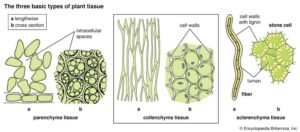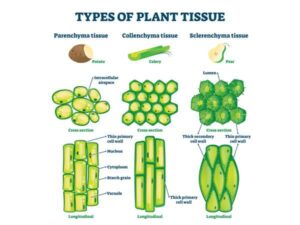Back to: Botany 300 Level
Hello, my brilliant friend! I hope you’re having a fantastic day! Have you ever noticed that some parts of a plant, like fruits and leaves, feel soft, while others, like stems and seed coats, feel tough? This difference comes from the three main types of plant tissues—parenchyma, collenchyma, and sclerenchyma. These tissues give plants strength, flexibility, and support to grow and survive in different environments.
Today, we’ll explore their structure and roles, so you can understand how plants stay strong and functional!
Parenchyma, collenchyma, sclerenchyma – structure and roles
Parenchyma: The All-Purpose Tissue
Parenchyma cells are the most common and basic plant cells. They are found in leaves, stems, roots, and fruits and perform multiple functions.
Structure of Parenchyma
Thin cell walls made of cellulose.
Large central vacuole for storing water and nutrients.

Living cells with active metabolism.
Usually loosely packed, leaving air spaces between them.
Roles of Parenchyma
Photosynthesis – In leaves, parenchyma cells contain chloroplasts and help in food production.
Storage – Store starch, proteins, oils, and water (e.g. in potatoes and yams).
Wound Healing and Regeneration – Help plants recover from injuries.
Transport – Assist in moving water and nutrients within the plant.
Example: Fruits like mango, tomato, and banana are soft because they contain parenchyma cells!
Collenchyma: The Flexible Support Tissue
Collenchyma cells provide strength and flexibility to young plants and growing parts. They help plants bend without breaking, just like how a rubber band stretches and returns to shape.
Structure of Collenchyma
Elongated cells with unevenly thickened cell walls.
Living cells that can stretch as the plant grows.
Found mostly in young stems, leaf stalks (petioles), and under the epidermis.
Roles of Collenchyma
Provides Mechanical Support – Strengthens young stems and leaves.
Allows Flexibility – Helps plants withstand wind and movement.
Assists in Growth – Supports fast-growing regions without restricting them.
Example: The crunchy texture of celery stalks comes from collenchyma cells!
Sclerenchyma: The Hard and Strong Tissue
Sclerenchyma cells are the toughest plant cells, providing maximum strength and support. They make wood, seed coats, and hard shells strong and durable.
Structure of Sclerenchyma
Very thick cell walls made of lignin, making them rigid.
Dead cells at maturity, meaning they no longer grow.

Two main types:
Fibres – Long, thin cells found in stems and leaves (e.g. jute and flax).
Sclereids (Stone Cells) – Short, thick-walled cells found in hard parts (e.g. nutshells, seed coats).
Roles of Sclerenchyma
Provides Rigidity and Strength – Supports mature plants and prevents breaking.
Protects Seeds and Fruits – Forms hard seed coats (e.g. beans, coconut shells).
Used in Fibre Production – Fibres from jute and hemp are used to make ropes and fabric.
Example: The hard shell of coconut and the gritty texture in pears are due to sclerenchyma cells!
A Simple Story to Understand These Tissues
Imagine a young tree growing in your backyard:
Parenchyma is like soft flesh inside fruits—it helps store food and supports growth.
Collenchyma is like rubber bands—it gives flexibility and allows movement.
Sclerenchyma is like a steel rod—it provides the strongest support.
All three work together to keep the plant alive, strong, and functional!
Summary
Parenchyma cells are soft, thin-walled, and living, helping in photosynthesis, storage, and healing.
Collenchyma cells are living, flexible, and have unevenly thickened walls, providing support in young stems and leaves.
Sclerenchyma cells are dead, thick-walled, and lignified, making plants hard and rigid.
Evaluation
- What are the main differences between parenchyma, collenchyma, and sclerenchyma?
- Why are sclerenchyma cells dead at maturity?
- How does collenchyma help plants survive in windy conditions?
- Where can parenchyma cells be found in a plant?
- What type of plant tissue makes coconut shells and jute fibres strong?
You are doing an amazing job! Look at you, learning how plants balance strength, flexibility, and storage just like a well-built house! Keep looking at plants around you, and you’ll start recognising how these tissues work. Keep learning with Afrilearn, and I’ll see you in the next exciting lesson. Stay curious and keep growing!
